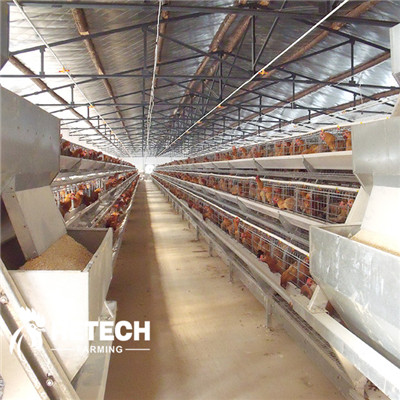The role of vitamins in raising chickens.
Vitamins are a special class of low-molecular-weight organic compounds necessary for poultry to maintain life, growth and development, normal physiological functions and metabolism.
Poultry has very little vitamin requirement, but it plays an important role in the metabolism of poultry body.
There are few microorganisms in the digestive tract of poultry, and most vitamins cannot be synthesized in the body, so they cannot meet the needs and must be taken from the feed.
When it is deficient, it will cause disorder of material metabolism, growth stagnation and various diseases, and even death in severe cases. Breeders and young chicks have stricter requirements for vitamins. Sometimes the egg production of chickens is not low, but the fertilization rate and hatching rate are not high, which is caused by the lack of certain vitamins.
1.Fat-soluble vitamins
1-1. Vitamin A (growth-promoting vitamin)
It can maintain normal vision, protect the normal function of epithelial cells and nerve tissue, promote the growth and development of poultry, increase appetite, promote digestion, and enhance the resistance to infectious diseases and parasites.
Lack of vitamin A in feed will lead to night blindness in poultry, slow growth, decreased egg production rate, decreased fertilization rate, low hatching rate, weakened disease resistance, and prone to various diseases. If there is too much vitamin A in the feed, that is, more than 10,000 international units/kg, it will increase the mortality of embryos in the early incubation period. Vitamin A is rich in cod liver oil, and carrots and alfalfa hay contain a lot of carotene.
1-2. Vitamin D
It is related to calcium and phosphorus metabolism in birds, promotes the absorption of calcium and phosphorus in the small intestine, regulates the excretion of calcium and phosphorus in the kidneys, and promotes normal calcification of bones.
When the poultry is deficient in vitamin D, the body’s mineral metabolism is disordered, which hinders the development of its bones, resulting in rickets, soft and bendable beaks, feet and sternum, thin or soft eggshells, decreased egg production and hatchability, poor growth, feathers Rough, weak legs.
However, too much vitamin D can lead to poultry poisoning. The vitamin D mentioned here refers to vitamin D3, because poultry has a strong ability to utilize vitamin D3, and cod liver oil contains more D3.
1-3. Vitamin E
It is related to the metabolism of nucleic acids and the redox of enzymes, maintains the complete function of cell membranes, and can promote immune function, improve the resistance of poultry to diseases, and enhance the anti-stress effect.
Poultry lack of vitamin E suffers from encephalomalacia, which will cause reproductive disorders, low egg production and hatchability. Adding vitamin E to feed can improve hatching rate, promote growth and development, and enhance immune function. Vitamin E is abundant in green fodder, grain germ and egg yolk.
1-4. Vitamin K
It is a component necessary for poultry to maintain normal blood coagulation, and is generally used to prevent and treat bleeding diseases caused by vitamin K deficiency. Lack of vitamin K in poultry is prone to hemorrhagic diseases, long clotting time, and damage to the tiny blood vessels, which can lead to massive bleeding. If the synthetic vitamin K content exceeds 1,000 times the normal requirement, poisoning will occur, and vitamin K is abundant in green fodder and soybeans.
2.water soluble vitamins
2-1. Vitamin B1 (thiamine)
It is related to maintaining the carbohydrate metabolism and neurological function of chickens, and is closely related to the normal digestive process. When the feed is lacking, the chickens show loss of appetite, muscle weakness, weight loss, indigestion and other phenomena. Severe deficiency manifests as polyneuritis with head tilted back. Thiamine is abundant in green fodder and hay.
2-2. Vitamin B2 (riboflavin)
It plays an important role in redox in vivo, regulates cellular respiration, and participates in energy and protein metabolism. In the absence of riboflavin, chicks grow poorly, with soft legs, inwardly curved toes, and small body. Riboflavin is abundant in green fodder, hay meal, yeast, fish meal, bran and wheat.
2-3. Vitamin B3 (pantothenic acid)
It is related to carbohydrate, protein and fat metabolism, dermatitis when lacking, rough feathers, stunted growth, short and thick bones, low survival rate, major heart and liver, muscle hypoplasia, hypertrophy of knee joints, etc. Pantothenic acid is very unstable and easily damaged when mixed with feed, so calcium salts are often used as additives. Pantothenic acid is abundant in yeast, bran and wheat.
2-4. Vitamin pp (niacin)
It is an important component of enzymes, which is converted into nicotinamide in the body, participates in the redox reaction in the body, and plays an important role in maintaining the normal function of the skin and digestive organs. The demand of chicks is high, loss of appetite, slow growth, poor feathers and shedding, curved leg bones, and low survival rate; lack of adult chickens, egg production rate, eggshell quality, hatching rate all decline. However, too much niacin in the feed will cause embryo death and low hatching rate. Niacin is abundant in yeast, beans, bran, green material, and fish meal.
Post time: Aug-01-2022









